#Cooling
Explore tagged Tumblr posts
Text
"As solar panels heat up beyond 25°C, their efficiency decreases markedly. Green roofs moderate rooftop temperatures. So we wanted to find out: could green roofs help with the problem of heat reducing the output of solar panels?
Our research compared a “biosolar” green roof — one that combines a solar system with a green roof — and a comparable conventional roof with an equivalent solar system. We measured the impacts on biodiversity and solar output, as well as how the plants coped with having panels installed above them.
The green roof supported much more biodiversity, as one might expect. By reducing average maximum temperatures by about 8°C, it increased solar generation by as much as 107% during peak periods. And while some plant species outperformed others, the vegetation flourished.
These results show we don’t have to choose between a green roof or a solar roof: we can combine the two and reap double the rewards...
How did the panels affect the plants?
In the open areas, we observed minimal changes in the vegetation cover over the study period compared to the initial planted community.
Plant growth was fastest and healthiest in the areas immediately around the solar panels. Several species doubled in coverage. We selected fast-growing vegetation for this section to achieve full coverage of the green roof beds as soon as possible.
The vegetation changed the most in the areas directly below and surrounding the solar panels. The Baby Sun Rose, Aptenia cordifolia, emerged as the dominant plant. It occupied most of the space beneath and surrounding the solar panels, despite having been planted in relatively low densities.
This was surprising: it was not expected the plants would prefer the shaded areas under the panels to the open areas. This shows that shading by solar panels will not prevent the growth of full and healthy roof gardens.
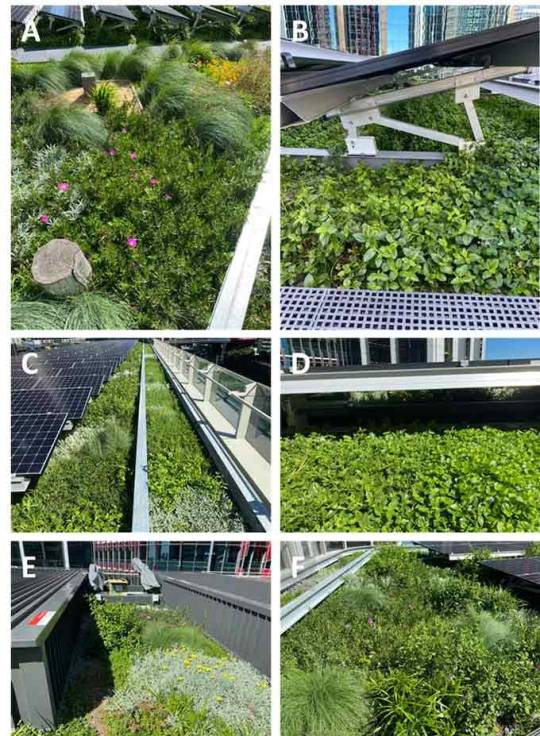
What were the biodiversity impacts?
We used environmental DNA (eDNA) surveys to compare biodiversity on the green roof and conventional roof. Water run-off samples were collected from both roofs and processed on site using portable citizen scientist eDNA sampling equipment to detect traces of DNA shed by the species on the roof.
The eDNA surveys detected a diverse range of species. These included some species (such as algae and fungi) that are not easily detected using other survey methods. The results confirmed the presence of bird species recorded by the cameras but also showed other visiting bird species went undetected by the cameras.
Overall, the green roof supported four times as many species of birds, over seven times as many arthropods such as insects, spiders and millipedes, and twice as many snail and slug species as the conventional roof. There was many times the diversity of microorganisms such as algae and fungi.
Encouragingly, the green roof attracted species unexpected in the city. They included blue-banded bees (Amegilla cingulata) and metallic shield bugs (Scutiphora pedicellata).
How did the green roof alter temperatures?
The green roof reduced surface temperatures by up to 9.63°C for the solar panels and 6.93°C for the roof surfaces. An 8°C reduction in average peak temperature on the green roof would result in substantial heating and cooling energy savings inside the building.
This lowering of temperatures increased the maximum output of the solar panels by 21-107%, depending on the month. Performance modelling indicates an extensive green roof in central Sydney can, on average, produce 4.5% more electricity at any given light level.
These results show we don’t have to choose between a green roof or a solar roof. We can combine them to take advantage of the many benefits of biosolar green roofs.
Biosolar roofs can help get cities to net zero
The next step is to design green roofs and their plantings specifically to enhance biodiversity. Green roofs and other green infrastructure may alter urban wildlife’s activities and could eventually attract non-urban species.
Our green roof also decreased stormwater runoff, removed a range of run-off pollutants and insulated the building from extremes of temperature. A relatively inexpensive system provides all of these services with moderate maintenance and, best of all, zero energy inputs.
Clearly, biosolar green roofs could make major contributions to net-zero cities. And all that’s needed is space that currently has no other use."
-via GoodGoodGood, May 12, 2024
#green#green roof#biosolar#solar power#solar panels#rooftop solar#solarpunk#native plants#australia#sydney australia#biodiversity#conservation#climate change#climate action#climate hope#global warming#temperature#climate adaptation#cooling#good news#hope
2K notes
·
View notes
Text

St. James' Church, Cooling, Kent, England, August 2024. (As featured in 'Great Expectations' by Charles Dickens.)
#photography#nature photography#nature#landscape#trees#church#sky#buildings#gravestones#literature#classic literature#cooling#kent#england#lensblr#photographers on tumblr#original photography#charles dickens
301 notes
·
View notes
Text
El sistema de enfriamiento de Audi es una obra de arte:
87 notes
·
View notes
Text
Good News - May 22-28
Like these weekly compilations? Support me on Ko-fi or $Kaybarr1735! Also, if you tip me on Ko-fi or CashApp (and give me some way to contact you if it doesn’t automatically), at the end of the month I'll send you a link to all of the articles I found but didn't use each week - almost double the content!
1. Scientists Invent Healthier More Sustainable Chocolate
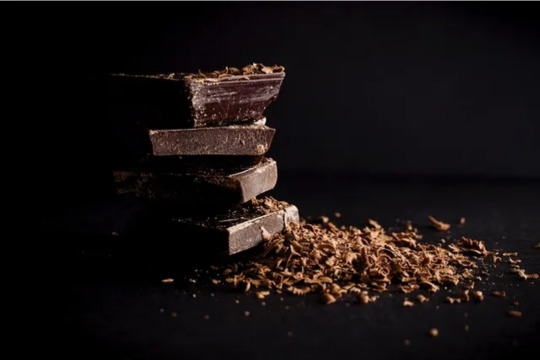
“The new chocolate recipe from researchers at ETH Zurich uses more materials from the cocoa pod that are usually discarded, including more of the pulp as well as the inner lining of the husk, known as the endocarp. […] The resulting chocolate also [was “deliciously sweet” and] had 20% more fibre and 30 percent less saturated fat than average European dark chocolate[, and] it could enable cocoa farmers [to] earn more from their crops.”
2. Vermont Is Coming for Big Oil, Making It Pay for Decades of Climate Pollution

“Legislators in Montpelier are on the brink of enacting the "Climate Superfund Act," modeled after the federal Superfund law, that seeks to make oil, gas and coal companies pay for damages linked to historical greenhouse gas emissions. […] Companies would be held liable for the costs associated with […] floods and heat waves, along with losses to biodiversity, safety, economic development and anything else the treasurer deems reasonable[, that were caused by their emissions].”
3. Important bird habitat now protected in the Rocky Mountain Trench
“Grassland-reliant species in the Rocky Mountain Trench now have more protected habitat thanks to a new [270-hectare] conservation area near Cranbrook. […] About one-third of the Skookumchuck Prairie Conservation Area is forested[…,] Most of the site is a dry grassland[…, and] Three hectares of wetlands add to the landscape diversity and offer crucial benefits to wildlife and water systems in the area. This conservation gem also provides habitat for endangered American badger and excellent winter range for elk, mule deer and white-tailed deer.”
4. Lemur Week marked by 70th breeding success

“A wildlife park has celebrated its 70th lemur breeding success ahead of a week raising money to help save the endangered primates. […] The park's open-air Madagascar exhibit is home to 31 free-roaming lemurs and was officially opened in 2008. […] Females are only sexually receptive for just one or two days a year, leaving a small window of opportunity for males to father offspring. […] The two playful siblings, one female and one male, were born to father Bernard and mother Hira.”
5. Innovative material for sustainable building
“Researchers introduce a polymer-based material with unique properties. This material allows sunlight to enter, maintains a more comfortable indoor climate without additional energy, and cleans itself like a lotus leaf. The new development could replace glass components in walls and roofs in the future.”
6. Isle of Wight eagles don't pose threat to lambs as feared

“While there had previously been fears that the eagles would feed on livestock, such as lambs, the project has found no evidence of this. [… “W]hite-tailed eagles effectively steal meals from other predatory birds[, which is] a really important ecological role that had been lost within the landscape and is being restored.” [… The birds’] population was boosted by a chick last year – the first time the species has bred in England in 240 years.”
7. Breakthrough discovery uses engineered surfaces to shed heat
“Cheng's team has found a way to lower the starting point of the [Leidenfrost] effect by producing a surface covered with micropillars. […] The discovery has great potential in heat transfer applications such as the cooling of industrial machines and surface fouling cleaning for heat exchangers. It also could help prevent damage and even disaster to nuclear machinery.”
8. New malaria vaccine delivered for the first time

“A total of 43,000 doses arrived by air today from UNICEF, and another 120,000 are scheduled to show up in the coming days. […] They're the first vaccines designed to work against a human parasite. […] Across four African countries, these trials showed a 75% reduction in malaria cases in the year following vaccination of young children. […] The Serum Institute of India, who will be manufacturing the new vaccine, says a hundred million doses will likely be available to countries by the middle of next year.”
9. Urban gardening may improve human health: Microbial exposure boosts immune system
“"One month of urban indoor gardening boosted the diversity of bacteria on the skin of the subjects and was associated with higher levels of anti-inflammatory cytokines in the blood. The group studied used a growing medium with high microbial diversity emulating the forest soil," [… whereas] the control group used a microbially poor peat-based medium. [… N]o changes in the blood or the skin microbiota were seen. […] “This is the first time we can demonstrate that meaningful and natural human activity can increase the diversity of the microbiota of healthy adults and, at the same time, contribute to the regulation of the immune system."”
10. Cities Are Switching to Electric Vehicles Faster Than Individuals
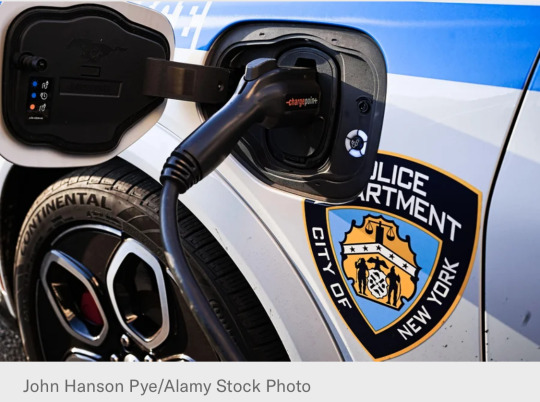
“[M]ost large cities have adopted some kind of climate goal, and some of them are buying EVs for their municipal fleets at a faster rate than the general public. And that progress could speed up as more EVs enter the market and as cities get educated about grant funding and tax incentives that were passed over the last four years.”
May 15-21 news here | (all credit for images and written material can be found at the source linked; I don’t claim credit for anything but curating.)
#hopepunk#good news#chocolate#sustainability#farming#health#vermont#big oil#oil companies#climate change#cooling#technology#nuclear#malaria#vaccine#africa#unicef#eagles#livestock#england#birds#electric vehicles#glass#energy efficiency#habitat#conservation#lemur#zoo#gardening#urban gardening
352 notes
·
View notes
Text
White or reflective paint is more effective at cooling cities than covering roofs in solar panels or greenery, scientists say, and could offer some relief on extremely hot summer days. Two separate studies looked at the effect of 'cool roofing' and found using white or reflective coatings could reduce outdoor city temperatures by up to 2 degrees Celsius. Scientists at University College London (UCL) used a model of Greater London to test various cooling methods against its hottest days of 2018, when the city endured a record-breaking summer.
Continue Reading.
234 notes
·
View notes
Text
Researchers report January 30 in the Cell Press journal Joule that a more efficient and environmentally friendly form of refrigeration might be on the horizon. The new technology is based on thermogalvanic cells that produce a cooling effect by way of a reversible electrochemical reaction. Thermogalvanic refrigeration is cheaper and more environmentally friendly than other cooling methods because it requires a far lower energy input, and its scalability means that it could be used for various applications -- from wearable cooling devices to industrial-grade scenarios. "Thermogalvanic technology is on its way to our lives, either in the form of clean electricity or low-power cooling, and both research and commercial communities should be paying attention," says senior author Jiangjiang Duan of Huazhong University of Science and Technology in Wuhan, China.
Read more.
#Materials Science#Science#Refrigeration#Thermogalvanic#Electrochemistry#Reactions#Cooling#Iron#Ions
44 notes
·
View notes
Text
Harnessing Hadrian’s heritage: Athens taps into ancient Roman aqueduct to turn down the heat | Euronews
59 notes
·
View notes
Text
Today my partner and I went out with a ladder and harvested mulberries in the neighborhood, I finally worked up the nerve after 4 years of watching fruit fall all over the road to ask if I could bring a ladder and do a proper mulberry harvest. My neighbors told me to have at it! So we got a tarp and shook branches we got almost half a gallon.
Then since we had the ladder out we stopped by the loquat/biwa trees on the way home and picked over 3 gallons of those since they were perfectly ripe and dropping.
Now I've made 2 quarts of mulberry syrup and a loquat curd. My partner made up a shortbread crust so we can have loquat bars and I'm making red fruit tea with syrup to have with the bars 💜
We have so many more loquats tho and I didn't realize how egg heavy fruit curds were so I'm on the fence about how to process our loquats, some jam could be good but canning is a fussy process, we could juice it or maybe make sorbet? I'm open to loquat use suggestions
You gotta make em fast tho cuz we spent 30 min just standing over the rink juice running down our chins inhaling loquats and I think we could possibly eat them.all in the next week if we give into the goblin fruit bounty urges
56 notes
·
View notes
Text

No Context Crow #312: Cooling Off Crow
Buy the print here!
#crows#corvids#corvidae#birds#animals#drawing#art#illustration#summer#summer vibes#warm weather#warm day#cooling#cooling off#I'm a big... FAN of this one#I'm sorry I had too#daily crows#crow queue#No Context Crow No. 312
197 notes
·
View notes
Text
"A recent World Meteorological Organization report called heat waves the “deadliest meteorological hazard” from 2015 to 2019, affecting people living on all continents, and setting new national heat records in many regions.
Canada’s top weather event in 2021 was British Columbia’s record-breaking heat, according to Environment and Climate Change Canada. The temperature in Lytton, B.C., hit 49.6 C on June 29. The following day a wildfire destroyed 90 per cent of the town, killing two people and displacing 1,200 others.
Heat waves also exacerbate existing health issues, including cardiovascular and respiratory disease. They’re associated with increased hospital admissions, psychological stress and aggressive behavior, as well as excess mortality.
During heat waves, the highest temperatures are often found in urbanized areas. Urbanization is almost always associated with an increase in paved, impervious areas, and often a decrease in greenery. Concrete and asphalt roads, and other built materials readily absorb, store and release heat, raising city temperatures, a phenomenon called the urban heat island.
Many studies have shown that urban forests can reduce the urban heat island, and many policies focus their attention on large green spaces.
Small green spaces, such as yards, rooftops and small parcels of undeveloped land, can make impressive contributions to lowering urban heat, but they are often overlooked when developing strategies for urban cooling.
The effect of small green spaces
Cities rarely have the opportunity to add large green spaces to help counter the effects of heatwaves. Smaller vegetated spaces, however, can still meaningfully decrease local land temperatures.
Small green spaces, such as yards, rooftops and small parcels of undeveloped land, can make impressive contributions to lowering urban heat, but they are often overlooked when developing strategies for urban cooling.
A recent study in Adelaide, Australia, found that tree canopy cover and, to a lesser extent, grass cover decreased local daytime surface temperatures by up to 6 C during extreme summer heat conditions. Further inland, suburban yards and gardens can decrease local surface temperatures up to 5 C.
At a quite small scale, on the order of tens of square metres, trees reduced daytime surface temperatures twice as much as grass cover. But grass and other small, low-lying plants, grow relatively quickly, compared to trees.
Cities should adopt short-term and long-term strategies to respond to extreme heat, including the replacement of paved and impervious surfaces with grasses and turf, and increasing tree plantings to boost canopy coverage.
Amplifying the cooling effect
Furthermore, when managing small green spaces, city planners and foresters can select tree species based on their ability to cool the environment. Green spaces with a high diversity of tree species have a greater cooling effect in spring, summer and fall. They also have a larger maximum drop in temperature in the summer, compared to spaces that are less diverse.
For example, tree canopies with large leaves and high transpiration rates — the evaporation of water from plants occurring at the leaves — could provide more cooling.
Planting a variety of species, of different heights, can have a larger cooling effect than tall trees alone.
The structure of green space may also influence its cooling efficiency. In summer, a plant community with multiple layers of trees, shrubs and herbs can further decrease air temperature by 1 C on a sunny day and 0.5 C on a cloudy day, compared with an area only dominated by tall trees...
But overall, trees usually have a stronger effect on cooling than grass. Planting trees in groups, not individually or in lines, is recommended for regulating the microclimate (local climate conditions near the Earth’s surface).
Small green spaces can offer a lot of summer cooling in cities. And cities can learn to manage the configuration of small green spaces better to get more cooling benefits and minimize the trade-offs."
-via GoodGoodGood, July 4, 2024
#green space#urban#urban landscape#urban forest#urban green spaces#food forest#permaculture#gardening#microclimate#cooling#conversation#global warming#climate change#climate action#solarpunk#rooftop garden#ecopunk#meterology#ecology#ecosystems#environmental science#plant trees#good news#hope
747 notes
·
View notes
Text

St. James' Church, Cooling, Kent, England, August 2024. (As featured in 'Great Expectations' by Charles Dickens.)
#photography#nature photography#nature#landscape#trees#church#buildings#gravestones#literature#classic literature#cooling#kent#england#lensblr#photographers on tumblr#original photography#charles dickens
337 notes
·
View notes
Text
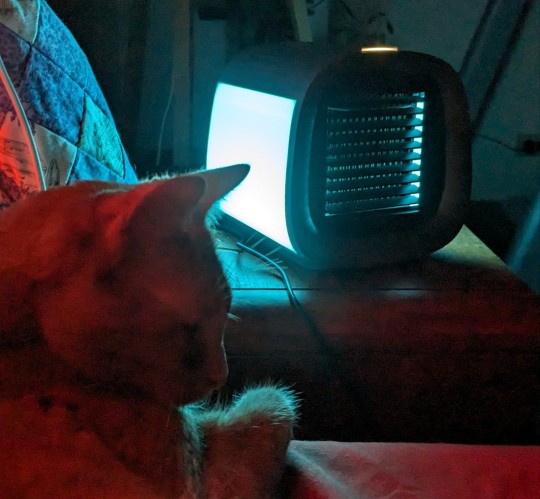
[ID: A photograph taken in the dark of the edge of my bed and nightstand; mostly what is visible is the illumination from my little personal cooler fan, which shows Polk the tabby, in shadow, sitting in front of it at the edge of the bed. ]
I have to say, I bought the little Evapolar Chill unit because I found it on an open-box sale and I was willing to risk $60 to see if it would help me keep my bedroom cool while the AC is out. It's a great little unit -- it takes less than ten watts an hour and runs on a USB, so you can run it from a normal electrical outlet with a USB adaptor, from a laptop, or from a sufficiently powerful backup battery. It's light enough to carry around, and each tank of water gets through roughly 4-10 hours depending on how high you've got the fan going.
It does not cool down the room. I think that's a losing proposition. But it does have four intensity settings and on the highest it'll cool about a ten-foot space very well, and on the lowest setting it's still powerful enough to cool a person lying in front of it (me) on the bed, without feeling like it's blowing air in my face. The cold just kind of trickles out, and you can see even Polkadot was enjoying the cool last night. I am sleeping MUCH better since running it on my bedside table, pointed down the bed. (The blue LED is a nice nightlight but also can be turned off.)
It comes with a biodegradable cartridge that needs replacing every 3-6 months of continuous use to the tune of $30, but feels worth it, especially since once my AC comes back in two weeks I'll probably use it mainly for summer stuff -- it'd be great to have at a beach party or a cookout. Or even just for use to cool down while sleeping if I want to keep the AC bill down occasionally.
Anyway it's a great little tool for what it is so do recommend.
107 notes
·
View notes
Text
How to survive the heat

Okay, let me talk about something else.
The climate is changing and it is getting hotter. The summers especially are getting hotter and hotter by the year and a lot of people are struggling with it.
As my American friends keep reminding me: The US - at least those areas, that have always been kinda hot - has usually ACs for most buildings. But someone sitting in Germany I can guarantee you: Most of us do not. At least not outside of commercial buildings like shopping malls and office buildings.
And still, we have temperatures over 30°C - at times going up to 40°C (that is like 86° - 104° in freedom units) - and somehow have to survive in here. So, as someone sitting in an attic flat with no AC in sight, let me talk survival.
Why heat is dangerous

Let me quickly talk about heat and why it is dangerous to us. And let me make it clear: Yes, heat is dangerous. Heat usually kills more people than any other type of extreme weather. Because while you can protect against most other weather, the heat is not that easy.
Our human fleshbags usually function best around 37°C (which is like 98.7°F) and to keep itself at around that temperature. When we are cold, our body burns energy to warm itself up. When we are hot, we produce sweat so that our bodies can cool of via evaporation.
The issue is, that our bodies are only able to do that in certain temperatures effectively.
And if we cannot cool off, our body will slowly fail. Additionally we might sweat so much, that we loose too much water through sweat, our bodies might shut off, too.
Just a quick graphic here. Just to make you aware. Because heat is dangerous.
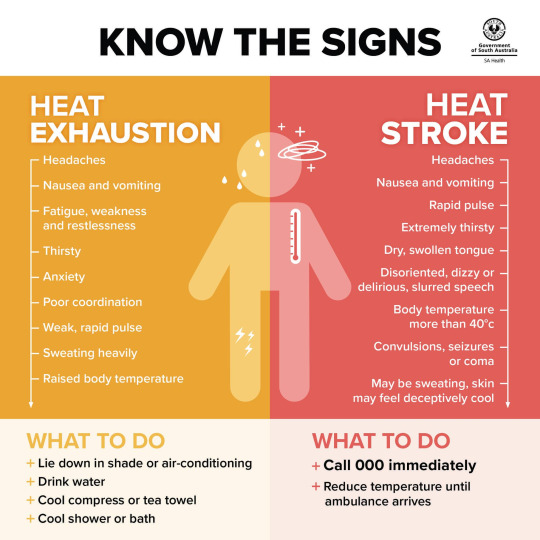
So, let us talk about something.
How to survive the heat without an AC?
Let me talk about my best friend during the summer heat: The fan. With that I mean the nice electric fan that keeps the air moving. Yes, it burns energy and that sucks, but with the air moving, our sweat can better evaporate, hence cooling us down.
Another thing that might help as well, is a device removing air humidity - because this, too, helps with sweating.
Then, of course, there is the good one: Air out your apartments early in the morning or throughout the night. When it is still cool. Then close up the windows during the day and close and curtains and blinds. If you do not have blinds, you might consider putting something against the windows from the outside. I personally use medical foil blankets, that are made to keep temperatures regulated. But please, please, if you do that: Put them up outside. Because otherwise it might harm the glass of the window. (And yes, sadly I have to remind you, too that you need to check with your landlord if this is okay.)
Another thing that might help you: Fill bottles with water and freeze them. Then put them up in the highest place in your room. This can lower the temperature in your room for a couple degrees. It is a very easy hack that works quite well.
Now, you might have heard about that drinking cold drinks is bad and that instead you actually should drink hot drinks. The science behind it is basically, that cold drinks do kinda cancel themselves out. Yes, cold drinks and ice cream cool down the inside of the body, but with it, it will also tell the body not to sweat. Because of that, you win nothing, but you also loose nothing. The natural temperature regulation gets stopped for a while, but for the same while your body gets cooled by the cold drink. So... It's alright. Do it the way you like. And yes, even though sweating is a good and healthy thing in the heat... It also kinda sucks.
Most importantly though: Drink. And drink something non-alcoholic. (Because alcohol dehydrates the body.) Other than that, it really does not matter what you drink. If it is hot or cold. Just make sure you drink about 2-3 liters a day. To make up for the loss of water through sweating.
The last tip I have is not good for the introverted. But... You might wanna consider spend your days in a place that is climatized. I usually sit in the office even on my off days, because it has a passive cooling system (yes, fancy sustainable stuff even!) and during the weekends I often go to the university library, because it is nice and climate controlled there.
Would I love to lounge around at home instead? Yes. Yes, I would. But... Beggers can't be choosers. And even my autistic ass prefers sitting in the library to having a heat stroke. Because yes, I had a heat stroke once. I cannot recommend it.
So, that said: Stay chilly.
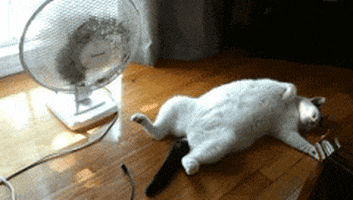
#summer#heat#heat stroke#heat exhaustion#cooling#sustainability#keeping cool#survival#tips#climate change
160 notes
·
View notes
Text
If you flick a handful of droplets on a very hot pan, you can watch them skitter and dance about. These droplets, believe it or not, are actually levitating. If a surface is hot enough, the heat will vaporize the side of the droplet closest to it, creating a cushion of gas on which the rest of the droplet hovers. This is known as the Leidenfrost effect, after German physician Johann Gottlob Leidenfrost, who documented the phenomenon in the 18th century. Now, a team of scientists has worked out a way to lower the temperature at which this little water dance occurs. A surface with a microscopic texture transfers heat to the droplets more effectively, a finding that has implications for heat transfer applications – such as cooling industrial machinery, and nuclear cooling towers.
Continue Reading.
67 notes
·
View notes
Text

Chalk-based coating creates a cooling fabric
In the scorching heat of summer, anyone who spends time outside—athletes, landscapers, kids at the park or beachgoers—could benefit from a cooling fabric. While there are some textiles that reflect the sun's rays or transfer heat away from the body, current options require boutique fibers or complex manufacturing processes. But now, researchers report a durable chalk-based coating that cools the air underneath treated fabric by up to 8 degrees Fahrenheit. Evan D. Patamia, a graduate student at the University of Massachusetts Amherst, will present their team's results at the fall meeting of the American Chemical Society (ACS). ACS Fall 2024 is a hybrid meeting being held virtually and in person from Aug. 18–22; it features about 10,000 presentations on a range of science topics. "If you walk out into the sunlight, you will get increasingly hot because your body and clothing are absorbing ultraviolet (UV) and near-infrared (near-IR) light from the sun," says Trisha L. Andrew, a chemist and materials scientist working with Patamia. "And as long as you're alive, your body is generating heat, which can be thought of as light, too."
Read more.
38 notes
·
View notes